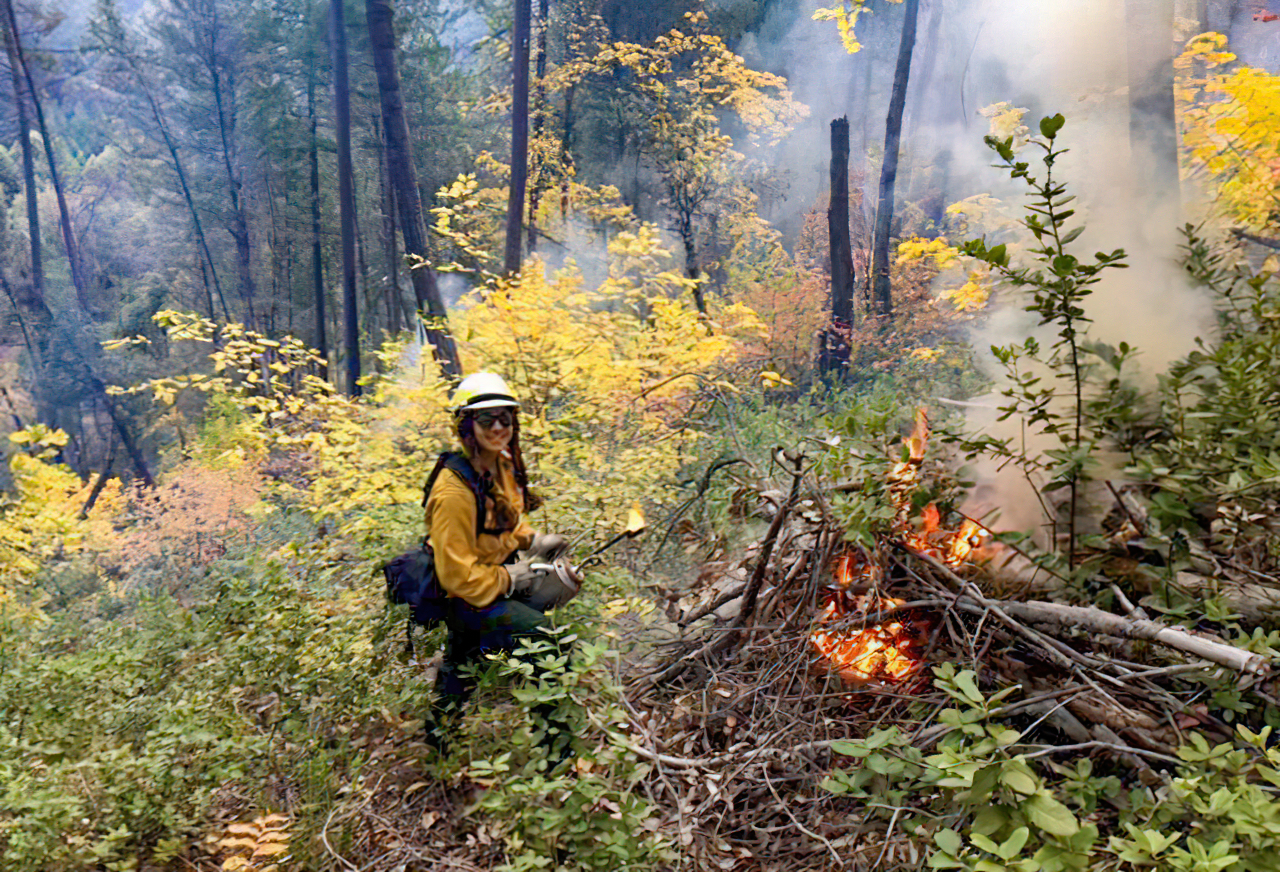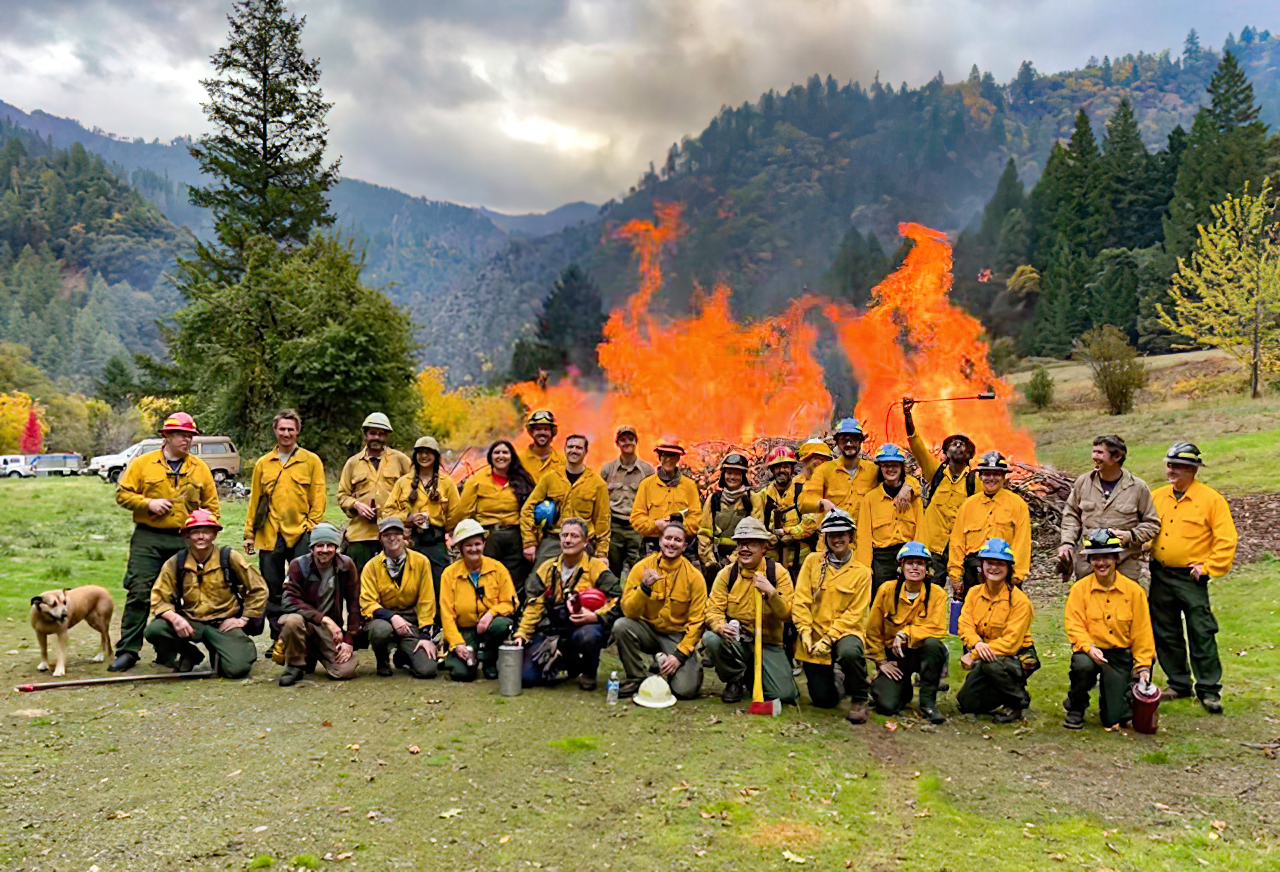Since 2014, this remote place has hosted a prescribed fire training exchange, known as the Klamath TREX.
Apprentice Alex Michel’s Reflections on a Prescribed Burn Training Exchange
By: Alex Michel
 Skies were overcast and a slight chill in the air mixed with the smell of smoke, sliding down steep mountain walls and settling in the valleys and rivers of the Klamath National Forest. It was 0730 as engines, buggies, trucks, and even some Priuses pulled into an art center parking lot across from a massive Sasquatch sculpture that keeps watch over the town of Happy Camp, California. Since 2014, this remote place has hosted a prescribed fire training exchange, known as the Klamath TREX, with a driving focus on “learning and burning” to aid fuel mitigation efforts that reduce destructive wildfire risk while addressing community and landscape-specific values and needs.
Skies were overcast and a slight chill in the air mixed with the smell of smoke, sliding down steep mountain walls and settling in the valleys and rivers of the Klamath National Forest. It was 0730 as engines, buggies, trucks, and even some Priuses pulled into an art center parking lot across from a massive Sasquatch sculpture that keeps watch over the town of Happy Camp, California. Since 2014, this remote place has hosted a prescribed fire training exchange, known as the Klamath TREX, with a driving focus on “learning and burning” to aid fuel mitigation efforts that reduce destructive wildfire risk while addressing community and landscape-specific values and needs.
This October, I had the great opportunity to be a part of a limited burn crew with members of the Central Coast Prescribed Burn Association (CCPBA) and participate in the Klamath TREX. The crew included CCPBA Director (J. Childress), Santa Cruz forester (C. Childress), founder of Cen Cal GIS (E. Aiken), Santa Lucia Conservancy Restoration Manager (J. Brooke), a local jack of all trades (C. Norton), and myself.
Other TREX attendees included new Firelighters (like me) to seasoned Burn Bosses, local Karuk tribal members, the Karuk Initial Attack crew (K-1 Crew), other engine and hand crews, as well as division supervisors, operations section chiefs, a medic with a great mustache, FEMOs, a GISS, an IMET, and others well-versed in and willing to explain the many acronyms. This confluence was possible thanks to the formation of a multi-organization task force including the Karuk Tribe, Mid Klamath Watershed Council (MKWC), local Fire Safe Councils and Volunteer Fire Departments, Salmon River Restoration Council, Nature Conservancy, US Forest Service, and other groups. This year’s attendees came from all around the US and as far as Ecuador, prepared and ready to help with a range of skills, experience, and knowledge. Needless to say, the objective to “develop and maintain interagency relationships” was attained.
Each morning, after a hearty breakfast, we circled up for a briefing led by Will Harling, the Mid Klamath Watershed Council (MKWC) Director, and Eric Darragh, the MKWC Fire and Fuels Program Director. Will and Eric reviewed the Incident Action Plan (IAP) for the day, a comprehensive document that contains incident objectives, an organization assignment list, division assignments, a safety plan, a radio communication plan, a medical plan, and incident maps. While some documents make good firestarter, I kept this plan rolled up and tucked safely into the side pocket of my nomex pants (along with snacks), referring to the maps constantly.
After the IAP briefing, we’d split into our assigned divisions and drive to public and private units located in Happy Camp, Somes Bar, Orleans, Weitchpec, and Forks of Salmon, where we conducted landscape-specific prescribed and pile burning operations. Each day, we put fire on the ground, using various tools to practice different firing patterns and holding techniques. We also learned about the local ecology, the history, and current uses of the culturally-sensitive lands we were burning. One purpose of prescribed fire is to promote the resilience of desired species, including fire-dependent species and cultural resources that people used for medicine, food, ceremonies, tools, and more. At the same time, prescribed fire clears unwanted invasive species and dangerous loads of vegetative fuels that build up and pose a wildfire threat to communities.
Each burn day brought a new lesson, like the skill of adaptability. Although our plans were prepared and printed, we still had to observe and adapt plans and methods as we went based on changing variables such as weather conditions, available resources, and time. For example, the plan on the first day was to broadcast burn in the understory of the forest, a practice in which ignition patterns encourage spots or lines of fire to connect and sweep across a decided burn unit.
That morning, an updated forecast showed rain, bringing with it wet conditions more conducive to pile burning: a type of prescribed burn with the purpose of igniting and consuming piles made of cut vegetation to reduce fuel loads (kind of like big bonfires). With the weather, the plan changed. However, while we were pile burning in a checkered pattern (skipping certain piles to monitor intensity and vertical flame length), the sun came out and dried out the 1-hour fuels (fuel sources which can change in as little as an hour in response to weather changes). Therefore, the plan changed again! These finer, “flashier” fuels consisting of vegetation smaller than a quarter-inch wide, such as leaf litter and dead annual grasses, did a good job of letting fire creep across the understory of the forest, making it possible to conduct a broadcast, or wider-spanning burn that connected the piles we lit.
As is also common in our prescribed grazing plans at TomKat Ranch, especially when working with several ever-changing systems, the plans we made were adapted, communicated across teams and the community, and carefully executed. Perhaps most importantly, participants got to see it all unfold and reflect on it in the After Action Review (AAR) at the end of the day.
Other skills we practiced and reflected on during the AARs included maintaining good communication between agencies and personnel, improving situational awareness, establishing systems of accountability, and much more. Having these boxes checked created safe conditions that allowed people to learn from each other, get the job done, and have a good time.
On day 4, our CCPBA crew—made up of people working in regenerative forestry and agriculture—took the opportunity to learn from the Fire Effects Monitor (FEMO) and GIS Specialist. As we spun weather, we discussed mapping and modeling strategies, wrote burn plans for different fuel types, and assessed the progression and effects of the fire we helped start. Having some experience in agriculture, forestry, and landscape architecture, I realized fire was another important lens I needed to view landscapes through.
There was something especially mesmerizing about using a drip torch. It was like painting the forest with fire. Each sweep of the torch sent a stream of fire carried by a mix of diesel and gas that connected the motions you drew in the air to the ground. On the other hand, blasting burn piles at full force with a propane torch was a little less graceful, but just as fun.
Aside from improving technical skills, I learned cornerstone concepts, like “slow is smooth, smooth is fast”, and the faux pas of fire, like wearing your grimy yellow Nomex shirt to the morning briefing area. I learned that chains of command keep things running smoothly but great value lies in the wisdom of those that have an intimate and ancestral understanding of the land they walk on every day. Personally, I learned that I can look up from a burn pile during a window in certain conditions, see fire and smoke surrounding me on all sides on a steep slope, and know that I’m fine. As my situational awareness and understanding of the versatility of fire increases, so does my comfort zone.
As much as I know now that managing fuels through prescribed fire and grazing reduces wildfire risk and literally saves land and lives, I know that a charge of this size can only be handled by collaborative efforts, sparking political changes, and educating communities so that they can take ownership and steward the lands that they love.
I’m very grateful to have had the opportunity to learn and participate in this year’s Klamath TREX. If they’ll have me, I’ll likely be found learning and carrying a drip torch around the Klamath mountains around the same time next year.


